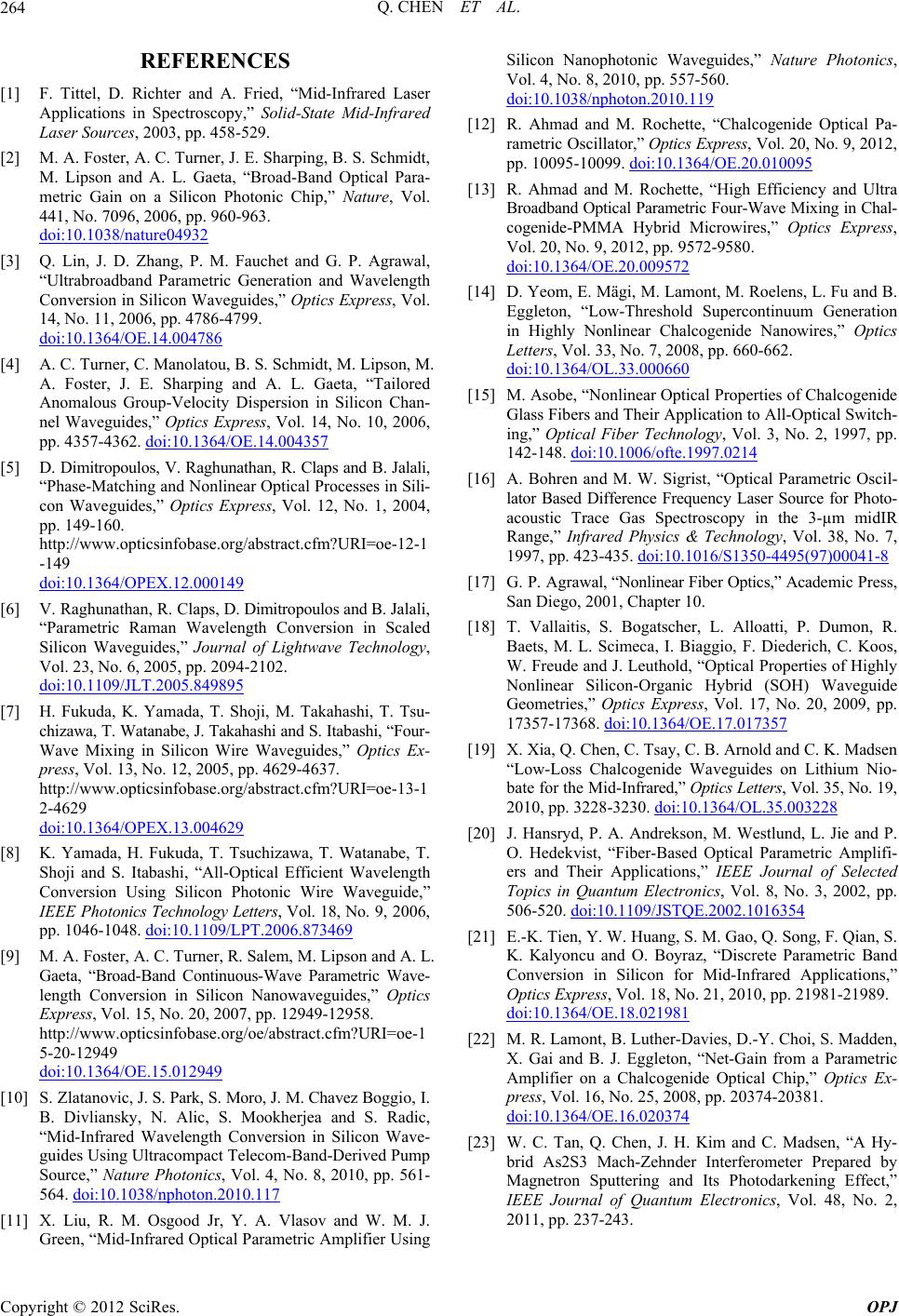
Q. CHEN ET AL.
Copyright © 2012 SciRes. OPJ
264
REFERENCES
[1] F. Tittel, D. Richter and A. Fried, “Mid-Infrared Laser
Applications in Spectroscopy,” Solid-State Mid-Infrared
Laser Sources, 2003, pp. 458-529.
[2] M. A. Foster, A. C. Turner, J. E. Sharping, B. S. Schmidt,
M. Lipson and A. L. Gaeta, “Broad-Band Optical Para-
metric Gain on a Silicon Photonic Chip,” Nature, Vol.
441, No. 7096, 2006, pp. 960-963.
doi:10.1038/nature04932
[3] Q. Lin, J. D. Zhang, P. M. Fauchet and G. P. Agrawal,
“Ultrabroadband Parametric Generation and Wavelength
Conversion in Silicon Waveguides,” Optics Express, Vol.
14, No. 11, 2006, pp. 4786-4799.
doi:10.1364/OE.14.004786
[4] A. C. Turner, C. Manolatou, B. S. Schmidt, M. Lipson, M.
A. Foster, J. E. Sharping and A. L. Gaeta, “Tailored
Anomalous Group-Velocity Dispersion in Silicon Chan-
nel Waveguides,” Optics Express, Vol. 14, No. 10, 2006,
pp. 4357-4362. doi:10.1364/OE.14.004357
[5] D. Dimitropoulos, V. Raghunathan, R. Claps and B. Jalali,
“Phase-Matching and Nonlinear Optical Processes in Sili-
con Waveguides,” Optics Express, Vol. 12, No. 1, 2004,
pp. 149-160.
http://www.opticsinfobase.org/abstract.cfm?URI=oe-12-1
-149
doi:10.1364/OPEX.12.000149
[6] V. Raghunathan, R. Claps, D. Dimitropoulos and B. Jalali,
“Parametric Raman Wavelength Conversion in Scaled
Silicon Waveguides,” Journal of Lightwave Technology,
Vol. 23, No. 6, 2005, pp. 2094-2102.
doi:10.1109/JLT.2005.849895
[7] H. Fukuda, K. Yamada, T. Shoji, M. Takahashi, T. Tsu-
chizawa, T. Watanabe, J. Takahashi and S. Itabashi, “Four-
Wave Mixing in Silicon Wire Waveguides,” Optics Ex-
press, Vol. 13, No. 12, 2005, pp. 4629-4637.
http://www.opticsinfobase.org/abstract.cfm?URI=oe-13-1
2-4629
doi:10.1364/OPEX.13.004629
[8] K. Yamada, H. Fukuda, T. Tsuchizawa, T. Watanabe, T.
Shoji and S. Itabashi, “All-Optical Efficient Wavelength
Conversion Using Silicon Photonic Wire Waveguide,”
IEEE Photonics Technology Letters, Vol. 18, No. 9, 2006,
pp. 1046-1048. doi:10.1109/LPT.2006.873469
[9] M. A. Foster, A. C. Turner, R. Salem, M. Lipson and A. L.
Gaeta, “Broad-Band Continuous-Wave Parametric Wave-
length Conversion in Silicon Nanowaveguides,” Optics
Express, Vol. 15, No. 20, 2007, pp. 12949-12958.
http://www.opticsinfobase.org/oe/abstract.cfm?URI=oe-1
5-20-12949
doi:10.1364/OE.15.012949
[10] S. Zlatanovic, J. S. Park, S. Moro, J. M. Chavez Boggio, I.
B. Divliansky, N. Alic, S. Mookherjea and S. Radic,
“Mid-Infrared Wavelength Conversion in Silicon Wave-
guides Using Ultracompact Telecom-Band-Derived Pump
Source,” Nature Photonics, Vol. 4, No. 8, 2010, pp. 561-
564. doi:10.1038/nphoton.2010.117
[11] X. Liu, R. M. Osgood Jr, Y. A. Vlasov and W. M. J.
Green, “Mid-Infrared Optical Parametric Amplifier Using
Silicon Nanophotonic Waveguides,” Nature Photonics,
Vol. 4, No. 8, 2010, pp. 557-560.
doi:10.1038/nphoton.2010.119
[12] R. Ahmad and M. Rochette, “Chalcogenide Optical Pa-
rametric Oscillator,” Optics Express, Vol. 20, No. 9, 2012,
pp. 10095-10099. doi:10.1364/OE.20.010095
[13] R. Ahmad and M. Rochette, “High Efficiency and Ultra
Broadband Optical Parametric Four-Wave Mixing in Chal-
cogenide-PMMA Hybrid Microwires,” Optics Express,
Vol. 20, No. 9, 2012, pp. 9572-9580.
doi:10.1364/OE.20.009572
[14] D. Yeom, E. Mägi, M. Lamont, M. Roelens, L. Fu and B.
Eggleton, “Low-Threshold Supercontinuum Generation
in Highly Nonlinear Chalcogenide Nanowires,” Optics
Letters, Vol. 33, No. 7, 2008, pp. 660-662.
doi:10.1364/OL.33.000660
[15] M. Asobe, “Nonlinear Optical Properties of Chalcogenide
Glass Fibers and Their Application to All-Optical Switch-
ing,” Optical Fiber Technology, Vol. 3, No. 2, 1997, pp.
142-148. doi:10.1006/ofte.1997.0214
[16] A. Bohren and M. W. Sigrist, “Optical Parametric Oscil-
lator Based Difference Frequency Laser Source for Photo-
acoustic Trace Gas Spectroscopy in the 3-µm midIR
Range,” Infrared Physics & Technology, Vol. 38, No. 7,
1997, pp. 423-435. doi:10.1016/S1350-4495(97)00041-8
[17] G. P. Agrawal, “Nonlinear Fiber Optics,” Academic Press,
San Diego, 2001, Chapter 10.
[18] T. Vallaitis, S. Bogatscher, L. Alloatti, P. Dumon, R.
Baets, M. L. Scimeca, I. Biaggio, F. Diederich, C. Koos,
W. Freude and J. Leuthold, “Optical Properties of Highly
Nonlinear Silicon-Organic Hybrid (SOH) Waveguide
Geometries,” Optics Express, Vol. 17, No. 20, 2009, pp.
17357-17368. doi:10.1364/OE.17.017357
[19] X. Xia, Q. Chen, C. Tsay, C. B. Arnold and C. K. Madsen
“Low-Loss Chalcogenide Waveguides on Lithium Nio-
bate for the Mid-Infrared,” Optics Letters, Vol. 35, No. 19,
2010, pp. 3228-3230. doi:10.1364/OL.35.003228
[20] J. Hansryd, P. A. Andrekson, M. Westlund, L. Jie and P.
O. Hedekvist, “Fiber-Based Optical Parametric Amplifi-
ers and Their Applications,” IEEE Journal of Selected
Topics in Quantum Electronics, Vol. 8, No. 3, 2002, pp.
506-520. doi:10.1109/JSTQE.2002.1016354
[21] E.-K. Tien, Y. W. Huang, S. M. Gao, Q. Song, F. Qian, S.
K. Kalyoncu and O. Boyraz, “Discrete Parametric Band
Conversion in Silicon for Mid-Infrared Applications,”
Optics Express, Vol. 18, No. 21, 2010, pp. 21981-21989.
doi:10.1364/OE.18.021981
[22] M. R. Lamont, B. Luther-Davies, D.-Y. Choi, S. Madden,
X. Gai and B. J. Eggleton, “Net-Gain from a Parametric
Amplifier on a Chalcogenide Optical Chip,” Optics Ex-
press, Vol. 16, No. 25, 2008, pp. 20374-20381.
doi:10.1364/OE.16.020374
[23] W. C. Tan, Q. Chen, J. H. Kim and C. Madsen, “A Hy-
brid As2S3 Mach-Zehnder Interferometer Prepared by
Magnetron Sputtering and Its Photodarkening Effect,”
IEEE Journal of Quantum Electronics, Vol. 48, No. 2,
2011, pp. 237-243.